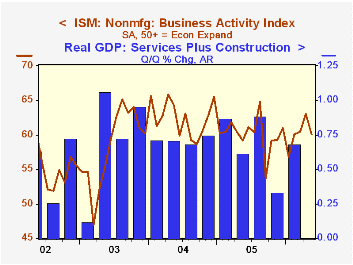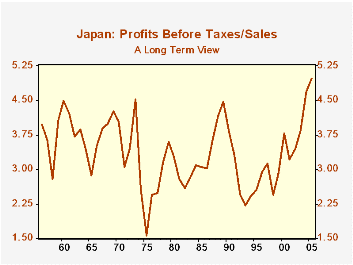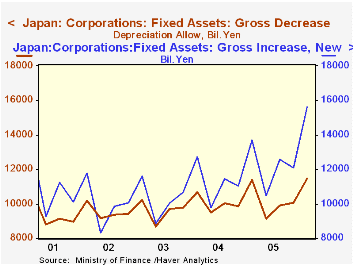 Global| Jun 05 2006
Global| Jun 05 2006ISM Nonmanufacturing Index Decline As Expected
by:Tom Moeller
|in:Economy in Brief
Summary
The Business Activity Index for the non-manufacturing sector in May retraced all of the gains posted during the prior two months. The nearly three point m/m decline to 60.1, reported by the Institute for Supply Management (ISM), was [...]

The Business Activity Index for the non-manufacturing sector in May retraced all of the gains posted during the prior two months. The nearly three point m/m decline to 60.1, reported by the Institute for Supply Management (ISM), was in line with Consensus expectations for a drop to 60.0.
For 2Q, the index has averaged 61.6 versus 59.1 during 1Q. Since the series' inception in 1997 there has been a 50% correlation between the level of the Business Activity Index and the q/q change in real GDP for services plus construction.
A five point decline in the new orders index to 59.6 gave back all of the prior month's improvement but the employment index rose for the second consecutive month to near the 2006 high. Since the series' inception in 1997 there has been a 60% correlation between the level of the ISM non-manufacturing employment index and the m/m change in payroll employment in the service producing plus the construction industries.
Pricing power surged to the highest level (77.5) since last September. Since inception eight years ago, there has been a 70% correlation between the price index and the y/y change in the GDP services chain price index.
ISM surveys more than 370 purchasing managers in more than 62 industries including construction, law firms, hospitals, government and retailers. The non-manufacturing survey dates back to July 1997.Business Activity Index for the non-manufacturing sector reflects a question separate from the subgroups mentioned above. In contrast, the NAPM manufacturing sector composite index is a weighted average five components.
New Views on Immigration from the Federal Reserve Bank of St. Louis can be found here.
| ISM Nonmanufacturing Survey | May | April | May '05 | 2005 | 2004 | 2003 |
|---|---|---|---|---|---|---|
| Business Activity Index | 60.1 | 63.0 | 59.2 | 60.1 | 62.5 | 58.3 |
| Prices Index | 77.5 | 70.5 | 62.4 | 67.9 | 68.8 | 56.6 |
by Louise Curley June 5, 2006

Corporate Financial data for nonfinancial corporations was published today and can be found in the Financial Section of Haver's Japan data base.
Profits before taxes for nonfinancial corporations in Japan rose 12.26% in the first quarter from the fourth quarter of last yearand were 4.05% above the first quarter of 2005. Profits as a percentage of sales reached are at an historically high level. To put the current data in perspective, we show, in the first chart, annual profits before taxes as a percentage of sales for the last fifty years. We use the annual data because of the seasonality in the quarterly data. In 2005, the percentage was 3.6% a figure not seen since the sixties and seventies. In the first quarter of this year, the ratio was 4.2%
Reflecting the improved profitability, nonfinancial corporations have stepped up capital spending. The excess of capital spending over depreciation allowances continues to grow as can be seen in the second chart. In the first quarter, capital spending increased 29.07% over the fourth quarter of last year and was 13.93% above the first quarter of 2005.Again, in view of the seasonality of the data, the year to year comparison is the more meaningful.
| Japan: Corporate Financial Statistics |
Q1 06 | Q4 05 | Q1 05 | Q/Q % | Y/Y % | 2005 | 2004 | 2003 |
|---|---|---|---|---|---|---|---|---|
| Sales (Trillion Yen) | 372.7 | 257.6 | 355.1 | 4.26 | 5.00 | 1378.1 | 1314.9 | 1257.1 |
| Profits Before Taxes (Trillion Yen) | 15.5 | 13.8 | 14.9 | 12.3 | 4.05 | 53.5 | 47.8 | 37.5 |
| Profits as Percent of Sales (%) | 4.2 | 3.9 | 4.2 | 0.3* | 0.0* | 3.6 | 3.0 | 2.7 |
| Capital Expenditures (Trillion Yen) | 15.6 | 12.1 | 13.7 | 29.07 | 13.93 | 48.8 | 45.0 | 41.1 |
| Depreciation Allowances (Trillion Yen) | 11.5 | 10.1 | 11.4 | 13.98 | 0.96 | 40.5 | 40.1 | 28.4 |
Tom Moeller
AuthorMore in Author Profile »Prior to joining Haver Analytics in 2000, Mr. Moeller worked as the Economist at Chancellor Capital Management from 1985 to 1999. There, he developed comprehensive economic forecasts and interpreted economic data for equity and fixed income portfolio managers. Also at Chancellor, Mr. Moeller worked as an equity analyst and was responsible for researching and rating companies in the economically sensitive automobile and housing industries for investment in Chancellor’s equity portfolio. Prior to joining Chancellor, Mr. Moeller was an Economist at Citibank from 1979 to 1984. He also analyzed pricing behavior in the metals industry for the Council on Wage and Price Stability in Washington, D.C. In 1999, Mr. Moeller received the award for most accurate forecast from the Forecasters' Club of New York. From 1990 to 1992 he was President of the New York Association for Business Economists. Mr. Moeller earned an M.B.A. in Finance from Fordham University, where he graduated in 1987. He holds a Bachelor of Arts in Economics from George Washington University.






